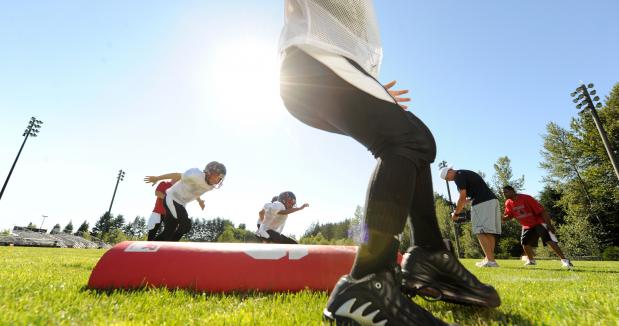4 things a parent needs to know about buying football cleats

One of the most important and challenging aspects of being a youth football parent is making sure that your child is properly outfitted before taking the field for practice and games. Cleats are a vital piece of apparel, and purchasing a pair for your child can be tricky, especially if you haven’t done it before.
Truth be told, it can be maddening even when you've gone through it many times before.
RELATED CONTENT: Always make sure youth football is fun for your children
A few years back, one of our son Bradley’s friends tried to convince him to get a pair of very expensive cleats bearing the name of an NFL player, a far cry from the shoes he'd worn in the past. That idea came to a screeching halt when he had difficulty getting them on his feet while trying them on in the store.
So what should a parent look for when buying cleats? There are several things to keep in mind.
1. Comfort over cost
When buying cleats for a youth football player, the most important aspect should be that they fit properly and don't empty your wallet.
“I wouldn’t so much worry about pricing and what kind of model I’m getting,” said Enzo Zucconi, director of equipment operations for Stony Brook University on Long Island. “I’m going to look for comfort and style of shoe.”
Try to avoid buying anything too expensive. They're only going to last one season.
2. Know what you're looking for
There are three types of cleats appropriate for youth football: screw-in, molded and rubber bottom. Since most games are played on grass or synthetic turf with the little rubber pieces, you want a shoe that can be used on both surfaces.
RELATED CONTENT: Players must treat teammates with respect, even when they don't get along
The rubber bottom cleat is probably the best in terms of both playing surfaces, while the cleated shoe is one to avoid.
“(It) is probably something that you don’t need when you’re 9 or 10,” Zucconi said. “The screw-in can hurt the bottom of your feet sometimes because the cleat is actually screwed into the bottom and presses against your forefoot or heel after a while.”
The cleated shoe comes in handy in the rain for extra traction. It can dig into the grass better than the molded or rubber cleat. The difference between the molded cleat and rubber cleat is that the former is made of a harder plastic.
3. What position is your child playing?
Young athletes should wear something that's functional and provides the support they need. But where your child lines up on the field can play a huge role in determining what pair of cleats to purchase.
“If you’re a skill guy, you can get some of the nice fancy lightweight cleats or a speed type of cleat that they have nowadays,” Zucconi said. “They’re very light and molded bottoms.”
If you’re on the offensive or defensive line, players are better off with a pair of cleats that are more sturdy and supportive.
“You want something that can handle the weight that you might have,” Zucconi said.
A lineman should wear a rubber bottom that will provide comfort, because they'll do a lot of drill work with their feet. The speed cleats might look good, but they’re not functional for someone who plays on the line.
4. It’s not a sneaker
This should be evident when you take your child to the sporting goods store to try on cleats. They have a different feel than a sneaker, and your child should try them on with all the lower-body football equipment necessary for practice or games.
“If you wear orthotics or ankle braces or you’re wearing a certain type of heavy sock, bring that with you,” Zucconi said.
RELATED CONTENT: 5 red flags sports parents shouldn't ignore
You want a sturdy cleat that won’t be as flexible as a pair of sneakers. The cleats will fit more like a pair of dress shoes.
“It’s going to be heavier than a sneaker,” Zucconi said. “They will break in over time, and they’ll feel nice and comfortable.
Eventually, the cleats will feel like a pair of sneakers.
Buying football cleats for a child is not an easy process. There are many different types and styles, but the most important thing is that the cleat is comfortable and durable while also being right for the position.
Peter Schwartz is a sports anchor for the CBS Sports Radio Network, FOX News Headlines 24/7 and WCBS 880 Radio in New York. His older son Bradley plays youth tackle football for the Super Bowl Champion East Meadow Rams on Long Island while his younger son Jared plays flag football for the LSW Giants. Peter, his wife Sheryl and the boys are busy cheering on the New York Jets when they’re not at a youth football field.
This is an updated version of a blog that originally published July 21, 2015.
